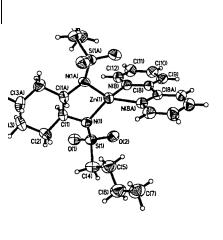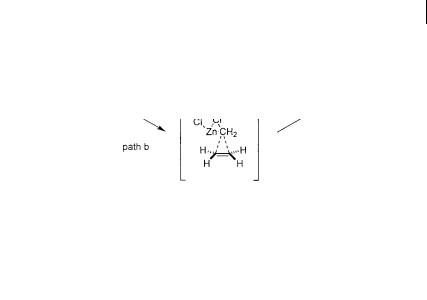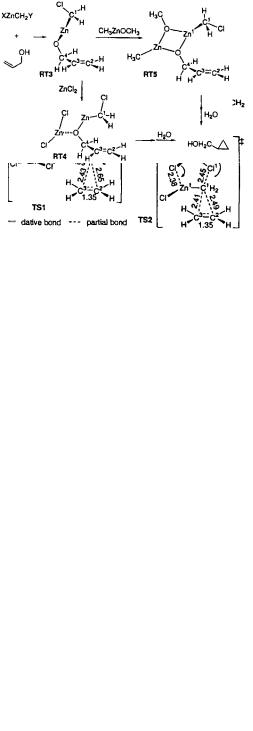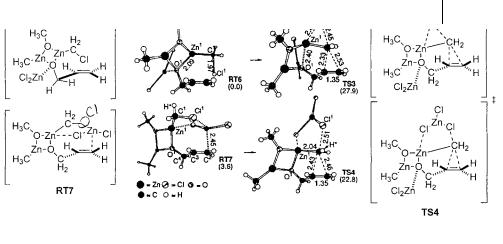
Cycloaddition Reactions in Organic Synthesis
.pdf
138 3 Enantioselective [2+1] Cycloaddition: Cyclopropanation with Zinc Carbenoids
sents a major gain in selectivity over the C2 symmetric isopropylsulfonamide 131d. A similar gain is observed with the mixed 1-naphthyl (131j) and trifluoromethyl (131k) sulfonamides. This increase in selectivity may indicate some degree of asymmetry in the stereochemistry determining transition structure. A steric differentiation may be favorable as demonstrated by 131i and 131j. However, Imai’s earlier results suggest that electronic differentiation may also play a major role. The importance of an electronic effect cannot be ruled out in this system since the unsymmetrical ligand 131k may give misleading results, because of conflicting metal-fluoride interactions (see 131h).
Employing protocol V with the methanesulfonamide catalyst 122, a 93 : 7 er can be obtained in the cyclopropanation of cinnamyl alcohol. This high selectivity translates well into a number of allylic alcohols (Table 3.12) [82]. Diand tri-substi- tuted alkenes perform well under the conditions of protocol V. However, introduction of substituents on the 2 position leads to a considerable decrease in rate and selectivity (Table 3.12, entry 5). The major failing of this method is its inability to perform selective cyclopropanations of other hydroxyl-containing molecules, most notably homoallylic alcohols.
Understanding the importance of the zinc alkoxide, the iodomethylzinc iodide and the zinc sulfonamide allowed Denmark to propose a revised transition state structure xv (Fig. 3.22) [82]. In this picture, the complex, polymetallic aggregate invoked by Rickborn and later by Kobayashi is featured.
In this model, the zinc sulfonamide is bridging the alkoxide and the ICH2ZnI. On the basis of sulfonamide aggregation and the role that the sulfonyl oxygen plays in that process, a stabilizing interaction between one of the sulfonyl oxygens and the zinc alkoxide is proposed. This interaction can be justified since it yields a stable, tetra-coordinate zinc species. The interaction of the sulfonyl oxygen with the zinc atom of the alkoxide reinforces facial selectivity by orienting the allylic alcohol chain on one side of the carbenoid. The importance of this interaction is supported by the work of Imai, while studies using this catalyst system do not provide unambiguous support (Table 11). Further direction is provided by the
Tab. 3.12 Substrate generality in the cyclopropanation
Entry |
Alcohol |
R1 |
R2 |
R3 |
t1/2 (min) |
Yield (%) |
Product |
er |
|
|
|
|
|
|
|
|
|
|
|
1 |
23 |
Ph |
H |
H |
< 3 |
92 |
24 |
95 |
: 5 |
2 |
132 |
PhCH2CH2 |
H |
H |
< 3 |
88 |
133 |
95 |
: 5 |
3 |
134 |
Ph |
Me |
H |
< 3 |
92 |
135 |
95 |
: 5 |
4 |
136 |
Me |
PhCH2CH2 |
H |
< 3 |
89 |
137 |
91 |
: 9 |
5 |
107e |
Ph |
H |
Me |
7 |
91 |
109e |
51 |
: 49 |
|
|
|
|
|
|
|
|
|
|

3.4 Stereoselective Simmons-Smith Cyclopropanations 139
Fig. 3.22 Denmark’s transition state assembly
spectator sulfonamide group. An alternative view of the transition state assembly xvi makes this clear (Fig. 3.23). To avoid steric interactions with the sulfonamide substituent, the allylic alcohol must extend out from the complex in a zigzag conformation. This interaction may rationalize the failings of bulky sulfonamides such as 131e and 131g. The close proximity of this group to the HC(2) of the allylic alcohol also rationalizes the low selectivities observed in the cyclopropanation of 2-substituted allylic alcohols. Close steric contact between the 2-substituent and the sulfonamide R group may destabilize this conformation and open a competing, unselective pathway.
In this model, the zinc sulfonamide acts as an organizational center for the transition state assembly. This agrees with many earlier studies, especially those involving chirally modified reagents, where a chiral zinc species is substituted for ZnI2. Further support for this hypothesis is provided by an X-ray crystal structure of the zinc sulfonamide catalyst (Fig. 3.24) [83]. This complex of the n-butanesul- fonamide catalyst 84b and 2,2 -bipyridyl around a central zinc atom confirms the proposed zinc sulfonamide structure in the hypothetical transition state xiv. The highly distorted coordination geometry of the zinc atom greatly enhances its Lewis acidity, rendering it capable of simultaneously coordinating two other components of the cyclopropanation reaction, namely the zinc alkoxide and the zinc carbenoid, ICH2ZnI.
These optimization studies are an important step in the study of SimmonsSmith cyclopropanations since they allowed for the development of a selective, catalytic method for introduction of a simple methylene unit. However, they also provide insights into the basic mechanism of this process. Together with earlier studies regarding carbenoid structure, the true nature of the reactive carbenoid, ICH2ZnI, was confirmed. On the basis of these results, a revised transition structure was proposed. Although there is no direct evidence for such a transition
Fig. 3.23 Alternative view of the transition state assembly

140 3 Enantioselective [2+1] Cycloaddition: Cyclopropanation with Zinc Carbenoids
Fig. 3.24 X-ray crystal structure of the 131b-bipy zinc complex. [Denmark, S.E.; O’Connor, S.O.; Wilson, S.R. Angew. Chem., Int. Ed. Eng. 1998, 37, 1149. Reprinted with permission from Wiley-VCH]
structure, the X-ray structure does confirm the ability of the zinc sulfonamide catalyst to assume the important role of a chiral, organizational center. This empirically derived model also serves as an important starting point for further investigations into the mechanism of this process.
3.5
Simmons-Smith Cyclopropanations – Theoretical Investigations
Because of the complexity of the pathway, the sensitivity of the reagents involved, the heterogeneous nature of the reaction, and the limitations of modern experimental techniques and instrumentation, it is not surprising that a compelling picture of the mechanism of the Simmons-Smith reaction has yet to emerge. In recent years, the application of computational techniques to the study of the mechanism has become important. Enabling theoretical advances, namely the implementation of density functional theory, have finally made this complex system amenable to calculation. These studies not only provide support for earlier conclusions regarding the reaction mechanism, but they have also opened new mechanistic possibilities to view.
Early in the study of the Simmons-Smith cyclopropanation, there was a debate regarding the fundamental mechanism of the process. One hypothesis claimed that the methylene transfer is a concerted electrophilic process. A second hypothesis argued for a nucleophilic mechanism akin to a carbometallation reaction. Although the experimental evidence rules out the carbometallation pathway (see Section 3.2) [10], it is still interesting to compare the conclusions from current theory with experimental observations. In 1998, Nakamura et al. computationally evaluated two limiting transition states for the cyclopropanation of ethene by the use of density functional theory (Scheme 3.35) – carbometallation (path a) and direct methylene transfer (path b) [84]. At the B3LYP/6–31G* level of theory, the energetics of the reaction can be evaluated using an intrinsic reaction coordinate

3.5 Simmons-Smith Cyclopropanations – Theoretical Investigations 141
(IRC) analysis. It is found that the methylene transfer (path b) is significantly favored over the carbometallation (path a) by about 13 kcal mol–1. The good agreement between theory and experiment indicates that such studies are valid for this complex system.
Scheme 3.35
The unique behavior of the zinc carbenoid compared with a free carbene has also been rationalized in a computational study. The experimental observation that zinc carbenoids do not undergo the C–H bond insertion processes characteristic of free carbenes has been addressed by Bottini et al. [85]. Again, a comparison between two mechanistic pathways was undertaken. At the B3LYP/6–31G* level of theory, a reaction system involving one ethene molecule and chloromethylzinc chloride can be evaluated (Fig. 3.25). After optimizing the geometries of the reactants and products, an examination of the singlet potential surface for the reaction leads to the identification of four energy minima corresponding to a reactantcarbenoid -complex, an addition transition state (TS1), an insertion transition state (TS2) and a product-zinc chloride complex. Computation of the IRC for the two transition states (TS1 + TS2) yields data regarding the energetics of the reaction (Fig. 3.25 a). The activation barrier proceeding from reactants to the addition transition state TS1 is found to be 24.75 kcal mol–1. The activation energy for the insertion transition state TS2 is much higher, 36.01 kcal mol–1. The energy difference demonstrates that addition is the kinetically favored process, a conclusion which is in complete agreement with experiment. Overall, both reaction pathways are still exothermic, with the insertion channel being almost 10 kcal mol–1 more exothermic than the addition channel.
This reactivity pattern can be rationalized in terms of a diabatic model which is based upon the principle of spin re-coupling in valence (VB) bond theory [86]. In this analysis the total wavefunction is represented as a combination of two electronic configurations arising from the reactant ( R) and from the product ( P). The contribution of these two configurations to the overall wavefunction varies as a function of the reaction coordinate. At the outset of the reaction, R is lower in energy than P, and hence R contributes heavily to the overall wavefunction

142 3 Enantioselective [2+1] Cycloaddition: Cyclopropanation with Zinc Carbenoids
Fig. 3.25 Comparison of insertion and addition reactions of zinc carbenoids. [Bernardi, F.; Bottini, A.; Miscione, G.P. J. Am. Chem. Soc. 1997, 119, 12 300. Reprinted with permission from The American Chemical Society]
( P(i) R(i)). As the reaction proceeds, the energy of P decreases relative to R, they attain degeneracy at the transition state and finally reverse positions upon reaching the products ( P(f) >> R(f)). The position of the transition state and the activation energy (Ea) are then functions of ER ( P(i)– R(i)), EP ( R(f)– P(f)) and H (Fig. 3.25b,c). The analysis shows that ER for the addition reaction is much smaller than ER for the insertion reaction. This large difference in ER can be directly related to the energy difference between a C–C double bond (60 kcal mol–1) and a vinylic C–H bond (108 kcal mol–1) [87]. On the product side,EP for the insertion reaction is much greater than EP for the addition reaction. This energy difference can again be rationalized through consideration of the bond energies. The contributions from these different energies, as shown in Fig. 3.25 b and c, lead to a decreased activation energy (Ea) for the addition reaction.
Theoretical analysis has also led to an understanding of the electrophilic nature of the zinc carbenoid. This is well established experimentally – electron-rich alkenes react more rapidly than the electron-deficient compounds [7]. Koch et al. have undertaken a careful investigation at the BLYP/6–31G* level of the frontier molecular orbitals involved in the Simmons-Smith reaction [88]. For this study, two reactive components were considered – ethene and iodomethylzinc iodide. In the addition transition state (TS1), the authors were able to divide the energetic contributions from the ethene and organozinc fragments (Fig. 3.26). Since the en-
ergy difference between |
C C |
|
is much less than the energy difference |
||
|
|
|
|
|
|
between C |
C and |
, it must be concluded that reaction is proceeding via the |
|||
|
|
C–Zn |
|
|
|

3.5 Simmons-Smith Cyclopropanations – Theoretical Investigations 143
former route. Such an orbital interaction is clearly indicative of an electrophilic attack the zinc reagent [89].
In 1998 Nakamura et al. undertook an investigation on the effect of Lewis acids on the Simmons-Smith cyclopropanation [90]. It is well established that Lewis acids such as ZnI2 play a major role in the cyclopropanation process. The role of the allylic alcohol as a directing group is another important factor which should be considered in any complete theoretical analysis. Most likely due to the complexity of such a calculation, earlier theoretical analyses have neglected these important reactive species when considering the energetics of the system. This ambitious study, conducted at the B3LYP/631A level of theory, examines the behavior and interactions of allyl alcohol, chloromethylzinc chloride and zinc chloride. For the sake of simplicity, the study is broken into three parts.
First, a simple model which incorporates only the zinc chloride and the chloromethylzinc chloride is considered to probe the nature of the Lewis acid activation. Two encounter complexes (RT1 and RT2) and their corresponding transition structures (TS1 and TS2) are found upon examination of the IRC (Fig. 3.27). In RT1, the Lewis acid is activating the carbenoid via binding across the Zn–Cl bond. The approach of ethene to RT1 leads to TS1, in which a 32% elongation of the CH2–Cl1 bond occurs. This is interpreted as representing an SN2-type displacement of chloride by the -electrons of ethene. Such a nucleophilic attack is consistent with the known electrophilic nature of such zinc carbenoids. In RT2, the Lewis acid is assisting in the departure of the chloride ion bound to the methylene unit. Approach of ethene leads to TS2. Again, a 31% elongation of the CH2–Cl1 bond is observed, consistent with a SN2-type displacement of chloride by ethene. By comparison, RT1 and TS1 are a much more conservative proposals which are in agreement with earlier conclusions regarding the cyclopropanation process. Despite this, theory predicts that the unconventional RT2 is slightly favored by 1.3 kcal mol–1.
Fig. 3.26 Frontier molecular orbital analysis for the Simmons-Smith cyclopropanation. [Dargel, T.K.; Koch, W. J. Chem. Soc., Perkin Trans. 1996, 2, 877. Reproduced by permission of The Royal Society of Chemistry]

144 3 Enantioselective [2+1] Cycloaddition: Cyclopropanation with Zinc Carbenoids
Fig. 3.27 Minimized structures for RT1, RT2, TS1 and TS2. [Nakamura, E.; Hirai, A.; Nakamura, M. J. Am. Chem. Soc. 1998, 120, 5844. Reprinted with permission from The American Chemical Society]
The next step in the calculations involves consideration of the allylic alcohol-carbe- noid complexes (Fig. 3.28). The simple alkoxide is represented by RT3. Coordination of this zinc alkoxide with any number of other molecules can be envisioned. The complexation of ZnCl2 to the oxygen of the alkoxide yields RT4. Due to the Lewis acidic nature of the zinc atom, dimerization of the zinc alkoxide cannot be ruled out. Hence, a simplified dimeric structure is represented in RT5. The remaining structures, RT6 and RT7 (Fig. 3.29), represent alternative zinc chloride complexes of RT3 differing from RT4. Analysis of the energetics of the cyclopropanation from each of these encounter complexes should yield information regarding the structure of the methylene transfer transition state.
Cyclopropanation proceeding through RT3 is calculated to have an activation energy of 35.7 kcal mol–1. Activation of the zinc alkoxide by ZnCl2 as in RT4 (by analogy to RT1), decreases the activation energy for reaction to 29.4 kcal mol–1. Cyclopropanation through the pseudo-dimeric structure RT5 leads to a further decrease in activation energy to 27.9 kcal mol–1 when compared to the unactivated RT3. The high energy barrier to cyclopropanation through RT3 is in clear agree-
Fig. 3.28 Minimized structures for RT3, RT4 and RT5. [Nakamura, E.; Hirai, A.; Nakamura, M. J. Am.
Chem. Soc. 1998, 120, 5844. Reprinted with permission from The American Chemical Society]

3.5 Simmons-Smith Cyclopropanations – Theoretical Investigations 145
Fig. 3.29 Minimized structures for RT6, RT6, TS3 and TS4. [Nakamura, E.; Hirai, A.; Nakamura, M. J. Am. Chem. Soc. 1998, 120, 5844. Reprinted with permission from The American Chemical Society].
ment with Charette’s observation that a simple iodomethylzinc alkoxide is unable to deliver a methylene to the neighboring double bond. However, the slight decrease in the activation barrier for the cyclopropanation seen in RT4 and RT5 still cannot rationalize the high reactivity of the zinc carbenoid.
Examination of cyclopropanation through RT6 and RT7 reveals that a less conventional explanation may be required to rationalize the high reactivity of zinc carbenoids (Fig. 3.29). The structure of RT6 represents a pseudo-dimer as shown in RT5 that has been further activated by coordination of zinc chloride to the oxygen of the chloromethylzinc alkoxide. This mode of activation is reminiscent of that observed in RT1. Cyclopropanation proceeding from RT6 through TS3 has an activation energy of 27.8 kcal mol–1. This represents a negligible decrease in the barrier to methylene transfer when compared to reaction from RT5.
This puzzling result again suggests that the traditional mode of Lewis acid activation (RT1) may not be effective for activation of the zinc carbenoid. Examination of RT7, a structure which represents a pseudo-dimer (RT5) which has been activated by zinc chloride through binding to Cl1, is an example of Lewis acid activation in the manner of the energetically favored RT2. Cyclopropanation from RT7 through TS4, with its five-membered ring containing the chloromethylzinc group, leads to a lowered activation barrier relative to earlier proposed transition states (22.8 kcal mol–1).
This study suggests a radically new explanation for the nature of Lewis acid activation in the Simmons-Smith cyclopropanation. The five-centered migration of the halide ion from the chloromethylzinc group to zinc chloride as shown in TS2 and TS4 has never been considered in the discussion of a mechanism for this reaction. It remains to be seen if some experimental support can be found for this unconventional hypothesis. The small energy differences between all these competing transition states demand caution in declaring any concrete conclusions.

146 3 Enantioselective [2+1] Cycloaddition: Cyclopropanation with Zinc Carbenoids
The activation energy for the favored transition state TS4 (22.8 kcal mol–1) is still somewhat high. Still, the qualitative predictions of enhanced reactivity of the zinc alkoxide-zinc chloride complexes are in full agreement with contemporary ideas about this reaction and represent a major advance in the theoretical understanding of the cyclopropanation process.
3.6
Conclusions and Future Outlook
Since its introduction in the late 1950s, the Simmons-Smith cyclopropanation has ascended as the single most general method for the simple cyclopropanation of alkenes. Although other cyclopropanation methods have proven to be effective, none has yet succeeded in the highly enantioselective transfer of a methylene unit. Aside from its synthetic utility, the Simmons-Smith cyclopropanation has raised many fascinating mechanistic issues that have challenged physical organic chemists throughout its 40 year history. Yet, despite major advances in the understanding of this process, many questions still remain.
This account has attempted to provide an integrated overview of the current understanding of the Simmons-Smith cyclopropanation. Simmons and Smith’s original hypotheses about this reaction have provided an excellent foundation for subsequent studies and evolved to form our basis of our current view of the process. Winstein and Dauben’s crucial discovery of the powerful directing effect of hydroxyl groups revealed the enabling opportunity for the development of stereocontrol in all of their various incarnations. The landmark insight provided by Rickborn’s proposal of a bimetallic transition state assembly represents another major advance that is subsumed by later proposals that rationalize and then design both diastereoand enantioselective cyclopropanations. The enlightening insights provided by Nakamura’s computational analysis may allow further refinement in our understanding of the various components in this deceptively simple process.
Great strides have been recorded in the invention of stereocontrolled cyclopropanations with zinc carbenoids from auxiliary-directed processes to chiral modifications of the reagent and substrate, to the emergence of catalytic enantioselective variants. Yet, with our current level of understanding and mechanistic knowledge, the generality and selectivity of this reaction are still less than those seen in the most useful of synthetic transformations. Advances beyond these limitations will require substantially new ideas about how to effect selective cyclopropanation. Among the most important challenges are the development of a new class of catalysts that provide a greater enhancement in reaction rate. Although empirical experimentation will always be useful, new advances in theory and in spectroscopic techniques may provide a deeper understanding of the origin of catalysis and suggest opportunities for stereoselection. Further, a current limitation is the requirement for a heteroatom-directing group. A major challenge is the development of a method that will accomplish the enantioselective delivery of methylene to an unfunctionalized alkene on the basis of steric interactions alone.

References 147
Whether these advances come from the study of zinc carbenoids, other organometallic sources, diazo precursors or as yet unrecognized sources of methylene transfer, it is our hope that this chapter will serve as a helpful starting point to guide future explorers of this fascinating landscape.
References
[1] |
Nozaki, H.; Moriuti, S.; Takaya, H.; |
|
p. 581. (d) Charette, A.B.; Marcoux, |
|
Noyori, R. Tetrahedron Lett. 1966, 5239. |
|
J.F. Synlett 1995, 1198. (e) Zeller, K.P.; |
[2] |
(a) Pfaltz, A. In Comprehensive Asym- |
|
Gugel, H. In Houben-Weyl: Methoden der |
|
metric Catalysis II; Jacobsen, E.N.; |
|
Organischen Chemie; Regitz, M., Ed.; |
|
Pfaltz, A.; Yamamoto, H., Eds.; Sprin- |
|
Georg Thieme, Stuttgart, 1989; Band EX- |
|
ger, Heidelberg, 1999; Chapter 16.1, |
|
IXb, p. 195. (f) Charette, A.B.; Beau- |
|
p. 513. (b) Lydon, K.M.; McKervey, M.A. |
|
chemin, A. Org. React. 2001, 57, in |
|
In Comprehensive Asymmetric Catalysis |
|
press. |
|
III; Jacobsen, E.N.; Pfaltz, A.; Yamamo- |
[7] |
(a) Simmons, H.E.; Smith, R.D. J. Am. |
|
to, H., Eds.; Springer, Heidelberg, 1999; |
|
Chem. Soc. 1958, 80, 5323. (b) Simmons, |
|
Chapter 16.2, p. 539. (c) Aratani, T. In |
|
H.E.; Smith, R.D. J. Am. Chem. Soc. |
|
Comprehensive Asymmetric Catalysis III; |
|
1959, 81, 4256. |
|
Jacobsen, E.N.; Pfaltz, A.; Yamamoto, |
[8] |
Doering, W.v.E.; Buttery, R.G.; Laugh- |
|
H., Eds.; Springer, Heidelberg, 1999; |
|
lin, R.G.; Chaudhuri, N. J. Am. Chem. |
|
Chapter 41.3, p. 1451. (d) Salaün, J. |
|
Soc. 1956, 78, 3224. |
|
Chem Rev. 1989, 89, 1247. (e) Rappoport, |
[9] |
(a) Hoberg, H. Justus Liebig’s Ann. Chem. |
|
Z., Ed.; The Chemistry of the Cyclopropyl |
|
1962, 656, 1. (b) Hoberg, H. Justus Lie- |
|
Group; Wiley, Chichester, 1987. (f) Rap- |
|
big’s Ann. Chem. 1967, 703, 1. |
|
poport, Z., Ed.; The Chemistry of the Cy- |
[10] |
Wittig, G.; Wingler, F. Chem. Ber. |
|
clopropyl Group; Wiley, Chichester, 1995. |
|
1964, 97, 2146. |
[3] |
(a) Doyle, M.P. Enantiomer 1999, 4, 621. |
[11] |
Winstein, S.; Sonnenberg, J.; DeVries, |
|
(b) Doyle, M.P.; Forbes, D.C. Chem. Rev., |
|
L. J. Am. Chem. Soc. 1959, 81, 6523. |
|
1998, 98, 911. (c) Evans, D.A.; Woerpel, |
[12] |
(a) Winstein, S.; Sonnenberg, J.; De- |
|
K.A.; Hinman, M.M.; Faul, M.M. J. Am. |
|
Vries, L. J. Am. Chem. Soc. 1961, 83, |
|
Chem. Soc. 1991, 113, 726. (d) Davies, |
|
3235. (b) Cope, A.C.; Moon, S.; Park, |
|
H.M.L. Curr. Org. Chem. 1998, 2, 463. (e) |
|
C.H. J. Am. Chem. Soc. 1962, 84, 4843. |
|
Davies, H.M.L.; Hutcheson, D.K. Tetra- |
|
(c) Cope, A.C.; Park, C.H.; Scheiner, P. |
|
hedron Lett. 1993, 34, 7243. |
|
J. Am. Chem. Soc. 1962, 84, 4862. (d) |
[4] |
Denmark, S.E.; Stavenger, R.A.; Fau- |
|
Corey, E.J.; Dawson, R.L. J. Am. Chem. |
|
cher, A.M.; Edwards, J.P. J. Org. Chem. |
|
Soc. 1963, 85, 1782. (e) Dauben, W.G.; |
|
1997, 62, 3375. |
|
Ashcraft, A.C. J. Am. Chem. Soc. 1963, |
[5] |
(a) Fritschi, H.; Leutenegger, U.; |
|
85, 3673. (f) Radlick, P.; Winstein, S. J. |
|
Pfaltz, A. Angew. Chem., Int. Ed. Engl. |
|
Am. Chem. Soc. 1964, 86, 1866. (g) Gin- |
|
1986, 25, 1005. (b) Lowenthal, R.E.; |
|
sig, R.; Cross, A.D. J. Am. Chem. Soc. |
|
Abiko, A.; Masamune, S. Tetrahedron |
|
1965, 87, 4629. (h) Sims, J.J. J. Org. |
|
Lett. 1990, 31, 6005. |
|
Chem. 1967, 32, 1751. |
[6] |
(a) Simmons, H.E.; Cairns, T.L.; Vladu- |
[13] |
Chan, J.H.H.; Rickborn, B. J. Am. |
|
chick, S.A.; Hoiness, C.M. Org. React. |
|
Chem. Soc. 1968, 90, 6406. |
|
1973, 20, 1. (b) Furukawa, J.; Kawabata, |
[14] |
Hoveyda, A.H.; Evans, D.A.; Fu, G.C. |
|
N. Adv. Organomet. Chem. 1974, 12, 83. |
|
Chem. Rev. 1993, 93, 1307. |
|
(c) Charette, A.B.; Lebel, H. In Compre- |
[15] |
Emschwiller, G. Compt. Rend. Acad. Sci. |
|
hensive Asymmetric Catalysis II; Jacobsen, |
|
Paris 1929, 188, 1555. |
|
E.N.; Pfaltz, A.; Yamamoto, H., Eds.; |
[16] |
(a) Howard, F.L. J. Res. Nat. Bur. Stand., |
|
Springer, Heidelberg, 1999; Chapter 16.3, |
|
A 1940, 24, 677. (b) Shank, R.S.; Shech- |
